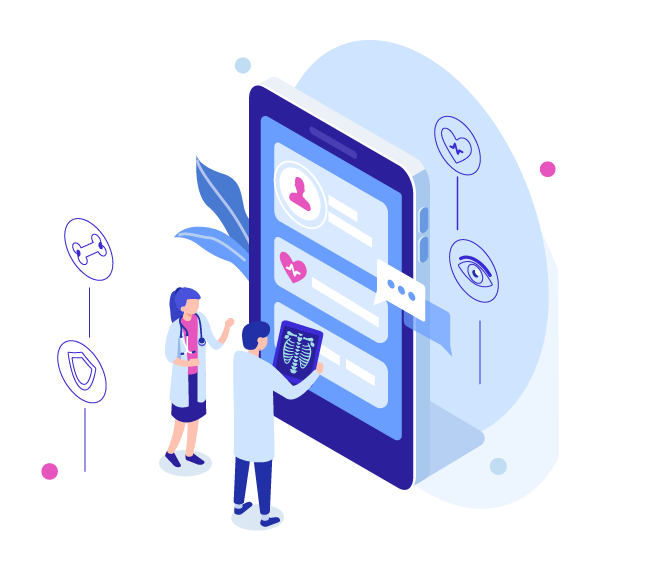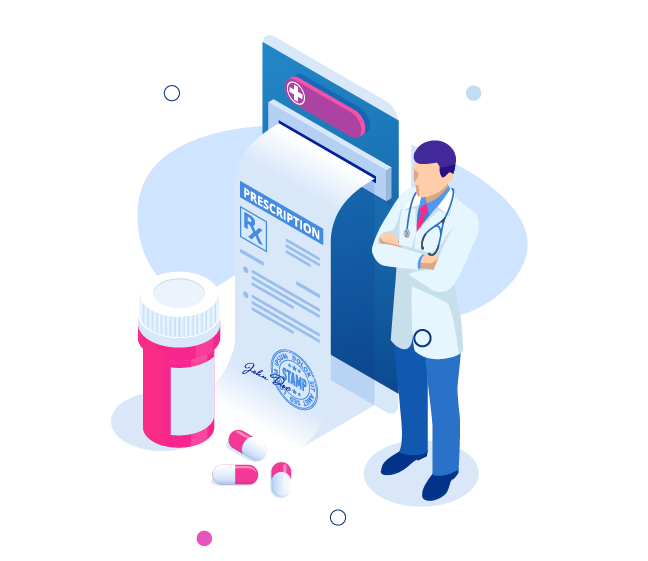The expectations and needs of patient experiences in the healthcare sector are changing. In the past, providing excellent patient care was enough for a successful practice and patient satisfaction. Today, the patient journey must involve high-quality service that meets patients’ needs and considers their experience.
As consumer models change in retail, research shows that patient expectations align closely with the general customer experience. Further research shows that 7 in 10 healthcare patients want their healthcare experience to be like online shopping.
How can healthcare and medical companies adapt to this retail model within their organization and offer patients an omnichannel approach to their healthcare experience?
Below are 6 strategies that can help your organization adapt to changing patient expectations and innovate the patient experience.
1. Create a 360-degree patient-centered journey

Patients are no longer passive in their healthcare journey. Where treatment and medication used to be the focus of patient care, the patient’s journey experience—such as the medication they receive, the human interactions they face, and the transparency from start to finish—is equally important.
This couldn’t be any more obvious when you consider a recent survey that found that just 61.5% of the patients felt involved in their care, while 1 in 10 stated that they would like to be more engaged in their treatment.
This patient-centered approach requires a fundamental shift in how organizations approach the care they give and how it is received. Healthcare professionals now need to concentrate on patient’s motivations and needs, and use multiple methods to help them identify what their patient wants from their care, such as the following:
Patient Surveys
Patient surveys are a great tool to gather large amounts of data from across your patient population, to understand how care and treatment is given, resulting in patient satisfaction. Surveys can be tailored based on the level of care they receive and are relatively simple to complete.
Data from patient surveys should be used to assess a baseline level of care, identify and act on improvements, and ensure necessary improvements are being made between one survey period and the next.
Patient Interviews
Face-to-face patient interviews take surveys that one step further, and allow for increased data quality. By properly planning patient interviews, you can initiate accurate patient screening, before assessing your target patient. These face-to-face interviews allow researchers to capture patient emotions and behaviors, capture verbal and non-verbal cues and ensure complete focus.
Patient Advocacy Consultations
In some cases, patients can’t, or are no longer able to, give feedback on their patient journey, but can often be the population that benefits the most from an improved patient experience journey.
Consulting with patient advocates – whether they are groups or individuals – allows for additional feedback that may be missed from patient surveys or interviews.
Using these methods to get a holistic understanding of the patient’s journey and their motivations can be highly beneficial to a tailored healthcare plan. However, remember that these are not constant and are subject to change through the patient’s experience.
2. Personalize Patient Communication Channels
For some patients, it may be their first time receiving significant healthcare treatment, and they will have no expectations of what they will face. Educating patients on what treatment(s) they are likely to receive and how it will happen can be a big first step to the patient journey.
In another example of focusing on patient education, 1 in 3 adults in the United States finds it challenging to read a prescription label. Finding alternate ways to provide medical information that they can understand and easily access will significantly increase the perception of how they view their care.
Offering alternative means to educate patients – such as infographics, self-service portals, and videos – will help break down complex jargon into easy-to-digest information and can help patients feel empowered and less confused.
Patients want to learn more about their diseases and what is being done to provide treatments that will improve or even cure their condition.
3. Optimize Patient Education
For many patients, approaching healthcare can be confusing. If they can not understand any information provided to them, they may feel disempowered
about their care.
For example, 1 in 3 adults in the United States finds it challenging to read a prescription label.5 Providing medical information that they can understand and easily access will significantly improve how they view their care. Infographics, self-service portals, and videos that break down complex jargon into easy-to-digest information can help patients feel empowered and less confused.
Patients want to learn more about their diseases and how life sciences organizations are innovating treatments that will improve or even cure their condition. Providing them with this information can significantly improve the patient experience.
4. Drive Effective Patient Outcomes

For much of modern medical history, patient outcomes have centered around, and been driven by the treatment. However, today health and medical organizations can drive more effective patient outcomes by identifying patient needs and what they want to receive from their care.
Identifying patient needs – through surveys, interviews, communication channels, etc. – can drive forward the care process and ensure that patients’ needs are taken into account.
To demonstrate this, the NIHR identified that including patients before and during trial design creates better study design and delivery for patients. Patient engagement and outcomes will increase when they understand how their treatment will meet their own needs and goals, and that their feedback proves valuable.
5. Sustain the Patient Journey with Digital Care

The COVID pandemic has changed what patients expect from technology in healthcare. Out of necessity, many hospitals, and life sciences organizations were forced to adopt virtual tools as 70% of patients deferred or canceled treatment.7
This shift to digital care helps overcome modern frustrations such as long appointment wait times or a lack of ‘traditional’ communication methods and empowers patients.
Research shows that patients are seeking omnichannel health experiences and, as a result, are more open than ever to embracing technology as part of their care. The same survey showed that 60% of the patients stated that they would like to use technology to communicate with healthcare professionals and help them manage their conditions.
In addition, artificial intelligence (AI) technology leveraged through chatbots, wearables, and machine learning is revolutionizing the way patients can access their healthcare providers more easily and monitor their condition outside of a hospital, ultimately improving their experience and outcomes.
Data analytics are also becoming critical in enhancing passive sensing, such as wearables and streamlining user-reported data. In a 2018 survey, 73% of respondents said they preferred monitoring their daily health metrics via wearables (eg, Fitbit data) – a 5% increase from 2016.
Many healthcare organizations are responding to this rising acceptance and demand for AI technology, with expert analysis expecting the clinical data analytics market to grow by an annual compounded growth rate of 33.07% from 2021 to 2026.
6. Measure the Success of Patient Engagement Outcomes

The shift from patient-centered care to treatment-centered care is something that takes time and that companies and organizations will have to continually adapt to. In order to ensure success in the patient’s needs and journey, metrics such as key performance indicators (KPIs) and return on investment (ROI) can help provide the data necessary to determine what changes are needed.
But identifying and calculating additional metrics, such as net promoter score (NPS) – a critical metric for how well you are achieving through word of mouth – and patient activation measure (PAM) – the measure of patient engagement in their healthcare – can generate greater patient insights.
By measuring and tracking the success of patient engagement initiatives, healthcare organizations can keep track of their patient engagement to ensure that they continue to provide the level of care that patients expect, and allows adjustment should you find that your patients are not responding to their initiatives as they hope they would.
Use Omnicare for a Superior Patient Experience
.png)
The points raised in this article should make it clear that the overall patient experience comes from effective communication channels with your patients coupled with active listening to their feedback and concerns.
The consumer retail landscape gives health and medical organizations a model to mimic for patient care, with strategic technology providing a solution to offer an efficient and effective patient journey. This type of experience can only be unlocked with a unified patient experience management platform that favors a technology-first, partnership mindset that is accessible to all key stakeholders simultaneously.
Exeevo’s Omnicare patient experience platform provides a single digital ecosystem built to improve the patient journey, whilst maximizing the benefits of data security and infrastructure from being built on the Microsoft Cloud for healthcare platform. By allowing patients to connect to different stakeholders, such as healthcare experts, providers, and skilled advisors within the healthcare system, we provide a platform for a superior patient experience.
To learn how Exeevo and Omnicare can help your organization create a unified, personalized, integrated, and enhanced patient experience, fill in the form below or contact us.
Explore the Personalized Experiences Offered by Omnicare

Resources
1. Deloitte. 2021 Global health care outlook. Retrieved from: https://www2.deloitte.com/global/en/pages/life-sciences-and-healthcare/articles/global-health-care -sector-outlook.html.
2. Business Wire. 2018. NTT DATA study finds nearly two-thirds of consumers expect healthcare digital experience to be more like retail. Retrieved from: https://www.businesswire.com/news/home/20180305005288/en/NTT-DATA-Study-Finds-Two-Thirds-Consumers-Expect.
3. Nuffieldtrust. 23 September 2021. Do patients feel involved in decisions about their care? Retrieved from: https://www.nuffieldtrust.org.uk/resource/do-patients-feel-involved-in-decisions-about-their-care.
4. Avtex. 2021. Omnichannel Healthcare Experience Report 2021. Retrieved from: https://avtex.com/resources/omnichannel-healthcare-experience-report.
5. Syneos Health. 2021. The critical success factor for fully realizing the benefits of decentralized trials. Retrieved from:
https://www.syneoshealth.com/insights-hub/critical-success-factor-fully-realizing-benefits-decentralized-trials.
6. NIHR. Engage patients to help shape your clinical research. Retrieved from: https://www.nihr.ac.uk/explore-nihr/industry/pecd.htm.
7. Accenture. 2020. How COVID-19 has permanently changed patient behavior. Retrieved from: https://www.accenture.com/us-en/insights/life-sciences/coronavirus-patient-behavior-research.
8. McKinsey & Company. 2019. Omnichannel consumer interactions — a payer perspective. Retrieved from: https://www.mckinsey.com/industries/healthcare-systems-and-services/our-insights/omnichannel-consumer-interactions-a-payer-perspective.
9. Mordor Intelligence. 2021. Clinical data analytics market – growth, trends, COVID-19 impact, and forecasts. Retrieved from: https://www.mordorintelligence.com/industry-reports/clinical-data-analytics-market-industry.
